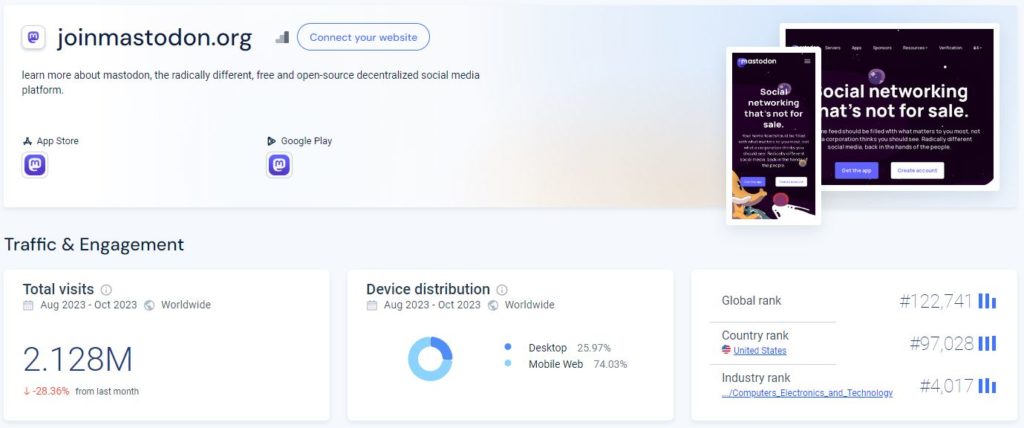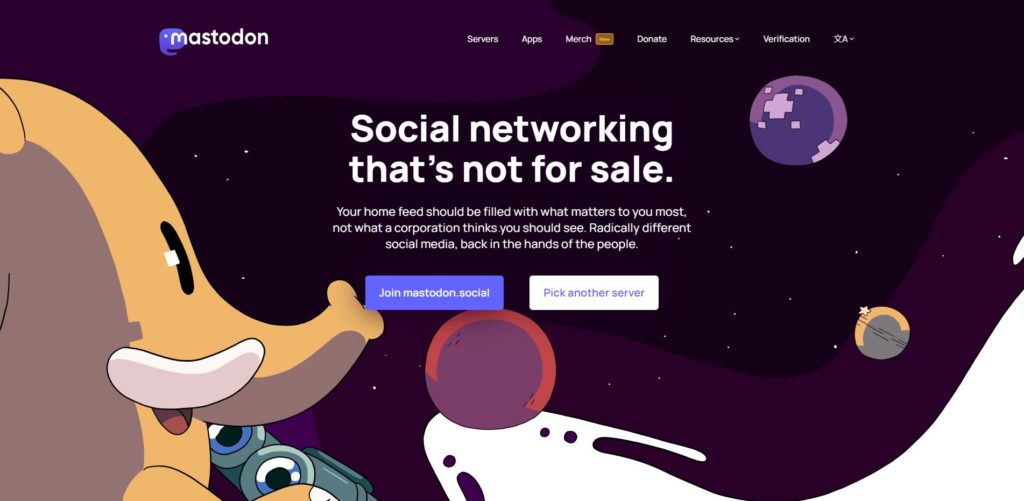
Is Mastodon Good for SEO?
Mastodon, emerging as a decentralized alternative to mainstream social media, was founded in 2016. It’s a unique platform, where instead of one central server, multiple servers – each with their own rules and communities – coexist. This setup is akin to a federation of mini social networks, each known as an “instance.” Mastodon stands out for its focus on privacy, community-driven content, and user control.
| Website: | joinmastodon.org |
| Founded: | 2016 |
| Type of Platform: | Decentralized, open-source microblogging social network |
| Key Features: | Audio, video, and picture posts, accessibility descriptions, polls, content warnings, animated avatars, custom emojis, chronological home feed |
| Content Types: | Text and multimedia posts |
| Popular Content: | “Toots” (posts), following other users, favoriting and boosting posts |
| Target Audience: | Users seeking a decentralized, open-source alternative to mainstream social media platforms |
| Domain Authority: | 88/100 |
This platform caters to a diverse audience, with content ranging from tech discussions to art and social commentary. Its decentralized nature means that some instances are highly specialized, attracting niche communities. Mastodon’s domain authority, while not on par with giants like Twitter or Facebook, is growing as its user base expands. Now, let’s talk about SEO, which stands for Search Engine Optimization. It’s the process of optimizing a website to rank higher in search engine results. This higher ranking means more visibility, leading to more traffic – a goal for any website.

Therefore, the question arises: Is Mastodon good for SEO? The platform’s growing popularity and domain authority suggest potential SEO benefits. However, these benefits are nuanced. Mastodon’s decentralized structure means that the SEO value can vary significantly from one instance to another. Some instances might have high domain authority and relevance in specific niches, while others may not contribute much to SEO efforts.
Most importantly, Mastodon’s content style and user engagement play a crucial role. The platform is known for fostering genuine interactions, which can lead to organic sharing and linking – both vital for SEO. But it’s crucial to understand that Mastodon’s impact on SEO isn’t direct. Instead, it’s about building relationships and creating share-worthy content that resonates with specific communities on the platform.
Are Mastodon Links Nofollow or Dofollow?
Mastodon uses nofollow links. Understanding the nature of backlinks on Mastodon hinges on the definitions of “Nofollow” and “Dofollow” links. In the realm of SEO, these terms are pivotal. Dofollow links are like votes of confidence, telling search engines to consider the link’s destination in their ranking algorithms. They pass along what’s known as “link equity,” potentially boosting the linked site’s search engine ranking. On the other hand, Nofollow links include a specific tag that tells search engines to ignore the link in terms of passing on link equity. They’re often used in situations where a website doesn’t want to fully endorse the linked page, like in user-generated content or certain types of sponsored links.

Now, let’s address the core question: Are Mastodon links Nofollow or Dofollow? Generally, Mastodon employs nofollow tags on links. This approach is a common practice on many social media platforms to discourage spam and prevent manipulation of search engine rankings. Mastodon’s use of nofollow links is consistent with its ethos of fostering genuine community interactions over SEO manipulation.
Therefore, while Mastodon links are predominantly Nofollow, understanding how to check a link’s type is a valuable skill, especially for those deeply invested in SEO and digital marketing strategies.
How Do I Add a Backlink to Mastodon?
Adding a backlink to Mastodon is a straightforward process, but before diving into that, let’s clarify what a backlink is. A backlink is essentially a link from one website to another. Think of it as a digital pointer or reference from one site to your content, which can be pivotal for driving traffic and improving SEO.
The Steps to Adding a Backlink
Here’s a step-by-step guide on how to add a backlink to Mastodon:
- Create Your Content: First, ensure you have content you want to link to. This could be a blog post, a web page, or any other online material that you wish to share.
- Sign Up or Log In to Mastodon: If you don’t have a Mastodon account, sign up for one. Choose an instance that aligns with the topic or ethos of your content for better audience relevance.
- Craft Your Mastodon Post: Once logged in, start composing your post. Be authentic and engaging; remember, the key on Mastodon is to contribute value to the community.
- Insert Your Link: Where relevant, insert the link to your content. You can do this by simply copying and pasting the URL into your post. Mastodon will automatically create a hyperlink. Remember, brevity is essential – keep your message concise and to the point.
- Add Context to the Link: Don’t just drop a link; add some commentary or a call-to-action to encourage engagement. Explain briefly what your link is about and why it might be interesting or useful to your followers.
- Use Relevant Hashtags: Enhance the visibility of your post by including relevant hashtags. This makes your post more discoverable to those interested in your topic.
- Engage with Replies and Boosts: After posting, stay active. Engage with any replies or comments to foster a connection with your audience. This engagement can lead to more shares (or “boosts” in Mastodon terms) and greater visibility.
- Monitor Your Post’s Performance: Keep an eye on how your post is performing. Understanding the engagement can provide insights for future posts and strategies.
Remember, Mastodon is a community-focused platform. While adding backlinks is part of a digital strategy, the primary focus should always be on contributing positively to the community and providing value. This approach not only respects the ethos of the platform but also naturally encourages more engagement with your content.
Best Practices for Posting on Mastodon
Navigating the landscape of a popular platform like Mastodon, Protopage, or Twitter requires an understanding of its unique culture and best practices. Here’s a concise guide on the dos and don’ts to ensure your posts resonate and engage effectively within this community.
The Do’s and Don’ts of Posting on Mastodon
Do’s:
- Be Genuine: Share content that’s authentic and true to your voice. Authenticity resonates more than overt marketing.
- Interact with Others: Respond to comments, engage in conversations, and be an active part of the community.
- Understand the Audience: Each Mastodon instance has its own culture and audience. Tailor your content to fit the interests and norms of the instance you’re posting in.
- Use Content Warnings: Be mindful of others. Use content warnings for sensitive topics, which is a much-appreciated practice on Mastodon.
- Provide Value: Share insightful, interesting, or entertaining content that adds value to the audience.
- Keep It Concise: Mastodon favors shorter, more straightforward posts. Keep your content clear and to the point.
Don’ts:
- Avoid Overpromotion: Excessive self-promotion or link-dropping can be off-putting. Balance your posts with genuine, non-promotional content.
- Read Instance Rules: Each Mastodon instance has its own set of rules. Ensure you’re familiar with and follow these guidelines.
- Avoid Controversial Content: Unless it’s relevant and handled sensitively, steer clear of divisive or controversial topics.
- Avoid Text Walls: Large blocks of text can be overwhelming. Use paragraphs and spacing to make your posts more readable.
- Check for Errors: Spelling and grammatical errors can detract from your message. A quick proofread goes a long way.
Most importantly, remember that Mastodon is a community-centric platform. Success here isn’t just about broadcasting your message; it’s about building genuine connections and contributing positively to the community. Keep these practices in mind, and you’ll be well on your way to making meaningful connections on Mastodon.
Does AmpiFire Submit to Mastodon?
Addressing the query of whether AmpiFire submits to Mastodon, unfortunately, AmpiFire does not directly submit content to Mastodon. Mastodon’s decentralized nature and diverse instances make it a unique platform, not typically covered by standard content distribution services like AmpiFire. However, this doesn’t diminish the utility of AmpiFire in a comprehensive digital marketing strategy.

Here are four key points explaining how AmpiFire works:
- Wide-Ranging Content Distribution: AmpiFire excels in distributing content across various platforms, including news sites, blogs, podcasts, and video platforms. This extensive reach ensures your content gains maximum exposure across diverse digital landscapes.
- Automated Content Creation and Distribution: A significant feature of AmpiFire is its automation capability. It can create and distribute different types of content, like articles and videos, saving time and effort in content creation and syndication.
- Performance Tracking: The platform offers tools to track the performance of your content. This feature allows you to see the impact of your distributed content, providing insights for future marketing strategies.
Although AmpiFire doesn’t directly post to Mastodon, its broad distribution network and SEO optimization capabilities make it a valuable tool in a marketer’s arsenal. Coupling AmpiFire’s strengths with targeted manual efforts on platforms like Mastodon can create a well-rounded and effective online presence.
Tired of not seeing organic results?
Discover AmpiFire and get your press releases be seen on Google News, YouTube, SlideShare, Apple Podcasts and many more…
Click Here To Learn More
Now, think about your digital strategy. Are you leveraging the unique opportunities platforms like Mastodon offer? And, do you see the potential in combining these with powerful tools like AmpiFire for a comprehensive digital presence? Share your thoughts – are decentralized platforms the future of social media engagement?
Frequently Asked Questions
Mastodon, with its unique decentralized nature and growing user base, offers potential SEO benefits, especially for niche markets. While its direct impact on SEO might not rival giants like Google, its community-driven platform can lead to organic engagement and sharing, which are valuable for SEO.
Mastodon primarily uses nofollow links, which don’t directly contribute to SEO like dofollow links do. However, they’re still valuable for driving traffic and building brand awareness. Comparatively, platforms like LinkedIn and Twitter also use nofollow links, but their larger user bases can potentially drive more traffic.
Adding backlinks on Mastodon is straightforward, involving simple post composition and link insertion. While these links are nofollow, they can still drive targeted traffic to your site, especially if your content resonates well with Mastodon’s community-focused audience.
Mastodon’s emphasis on community engagement and privacy sets it apart. Best practices include genuine interaction and respecting the platform’s culture. This approach differs from platforms like Facebook or Instagram, where broader marketing strategies might be more effective.
No, AmpiFire does not submit content to Mastodon. AmpiFire excels in distributing content across a wide range of other platforms and automates both content creation and SEO optimization, making it a versatile tool in digital marketing strategies.
Mastodon’s decentralized structure offers a unique, niche-focused audience engagement, which can be more intense and community-centric compared to broader platforms like Facebook or Twitter. This can lead to deeper connections but might require more effort in building these relationships.
